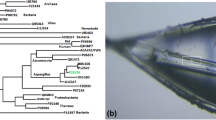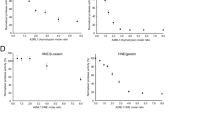Abstract
Human tryptase, a mast-cell-specific serine proteinase that may be involved in causing asthma and other allergic and inflammatory disorders1,2,3, is unique in two respects: it is enzymatically active only as a heparin-stabilized tetramer, and it is resistant to all known endogenous proteinase inhibitors. The 3-Å crystal structure of human β-tryptase in a complex with 4-amidinophenyl pyruvic acid shows four quasi-equivalent monomers arranged in a square flat ring of pseudo 222 symmetry. Each monomer contacts its neighbours at two different interfaces through six loop segments. These loops are located around the active site of β-tryptase and differ considerably in length and conformation from loops of other trypsin-like proteinases. The four active centres of the tetramer are directed towards an oval central pore, restricting access for macromolecular substrates and enzyme inhibitors. Heparin chains might stabilize the complex by binding to an elongated patch of positively charged residues spanning two adjacent monomers. The nature of this unique tetrameric architecture explains many of tryptase's biochemical properties and provides a basis for the rational design of monofunctional and bifunctional tryptase inhibitors.
This is a preview of subscription content, access via your institution
Access options
Subscribe to this journal
Receive 51 print issues and online access
$199.00 per year
only $3.90 per issue
Buy this article
- Purchase on Springer Link
- Instant access to full article PDF
Prices may be subject to local taxes which are calculated during checkout






Similar content being viewed by others
References
Caughey, G. H. Mast Cell Proteases in Immunology and Biology (Marcel Dekker, New York, 1995).
Caughey, G. H. Of mites and men: trypsin-like proteases in the lungs. Am. J. Respir. Cell Mol. Biol. 16, 621–628 (1997).
Seife, C. Blunting nature's swiss army knife. Science 277, 1602–1603 (1997).
Schwartz, L. B.et al. The alpha form of human tryptase is the predominant type present in blood at baseline in normal subjects and is elevated in those with systemic mastocytosis. J. Clin. Invest. 96, 2702–2710 (1995).
Sakai, K., Ren, S. & Schwartz, L. B. Anovel heparin-dependent processing pathway for human tryptase. Autocatalysis followed by activation with dipeptidyl peptidase I. J. Clin. Invest. 97, 988–995 (1996).
Schwartz, L. B. Tryptase: a mast cell serine protease. Methods Enzymol. 244, 88–100 (1994).
Alter, S. C., Metcalfe, D. D., Bradford, T. R. & Schwartz, L. B. Regulation of human mast cell tryptase. Effects of enzyme concentration, ionic strength and the structure and negative charge density of polysaccharides. Biochem. J. 248, 821–827 (1987).
Schechter, N. M., Eng, G. Y. & McCaslin, D. R. Human skin tryptase: kinetic characterization of its spontaneous inactivation. Biochemistry 32, 2617–2625 (1993).
Addington, A. K. & Johnson, D. A. Inactivation of human lung tryptase: evidence for a re-activatable tetrameric intermediate and active monomers. Biochemistry 35, 13511–13518 (1996).
Sommerhoff, C. P.et al. AKazal-type inhibitor of human mast cell tryptase: isolation from the medical leech Hirudo medicinalis, characterization, and sequence analysis. Biol. Chem. Hoppe-Seyler 375, 685–694 (1994).
Stubbs, M. T.et al. The three dimensional structure of recombinant leech-derived tryptase inhibitor in complex with trypsin: implications for the structure of human mast cell tryptase and its inhibition. J. Biol. Chem. 272, 19931–19937 (1997).
Kam, C. M.et al. Mammalian tissue trypsin-like enzymes: substrate specificity and inhibitory potency of substituted isocoumarin mechanism-based inhibitors, benzamidine derivatives, and arginine fluoroalkyl ketone transition-state inhibitors. Arch. Biochem. Biophys. 316, 808–814 (1995).
Clark, J. M., Moore, W. R. & Tanaka, R. D. Tryptase inhibitors: a new class of antiinflammatory drugs. Drugs Future 21, 811–816 (1996).
Johnson, D. A. & Barton, G. J. Mast cell tryptases: examination of unusual characteristics by multiple sequence alignment and molecular modeling. Protein Sci. 1, 370–377 (1992).
Matsumoto, R., Sali, A., Ghildyal, N., Karplus, M. & Stevens, R. L. Packaging of proteases and proteoglycans in the granules of mast cells and other hematopoietic cells. A cluster of histidines on mouse mast cell protease 7 regulates its binding to heparin serglycin proteoglycans. J. Biol. Chem. 270, 19524–19531 (1995).
Fujinaga, M., Chernaia, M. M., Halenbeck, R., Koths, K. & James, M. N. The crystal structure of PR3, a neutrophil serine proteinase antigen of Wegener's granulomatosis antibodies. J. Mol. Biol. 261, 267–278 (1996).
Bode, W. & Schwager, P. The refined crystal structure of bovine beta-trypsin at 1.8 Å resolution. II. Crystallographic refinement, calcium binding site, benzamidine binding site and active site at pH 7.0. J. Mol. Biol. 98, 693–717 (1975).
Walter, J. & Bode, W. The X-ray crystal structure analysis of the refined complex formed by bovine trypsin and p-amidinophenylpyruvate at 1.4 Å resolution. Hoppe-Seyler's Z. Physiol. Chem. 364, 949–959 (1983).
Stürzebecher, J., Prasa, D. & Sommerhoff, C. P. Inhibition of human mast cell tryptase by benzamidine derivatives. Biol. Chem. Hoppe-Seyler 373, 1025–1030 (1992).
Caughey, G. H., Raymond, W. W., Bacci, E., Lombardy, R. J. & Tidwell, R. R. Bis(5-amidino-2-benzimidazolyl)methane and related amidines are potent, reversible inhibitors of mast cell tryptases. J. Pharmacol. Exp. Ther. 264, 676–682 (1993).
Fiorucci, L., Erba, F., Bolognesi, M., Coletta, M. & Ascoli, F. pH dependence of bovine mast cell tryptase catalytic activity and of its inhibition by 4′, 6-diamidino-2-phenylindole. FEBS Lett. 408, 85–88 (1997).
Bode, W. & Huber, R. Natural protein proteinase inhibitors and their interaction with proteinases. Eur. J. Biochem. 204, 433–451 (1992).
Otwinowski, Z. & Minor, W. DENZO: a Film Processing for Macromolecular Crystallography (Yale Univ., 1993).
Navaza, J. An automated package for molecular replacement. Acta Crystallogr. A 50, 157–163 (1994).
Roussel, A. & Cambilleau, C. TurboFRODO in Sillicon Graphics Geometry (Sillicon Graphics, Mountain View, California, 1989).
Collaborative Computational Project No. 4. The CCP4 suite: programs for protein crystallography. Acta Crystallogr. D 50, 760–763 (1994).
Brünger, G. J. XPLOR (version 3.1). A System for X-ray Crystallography and NMR (Yale Univ. Press, 1993).
Nicholls, A., Bharadwaj, R. & Honig, B. GRASP — graphical representation and analysis of surface properties. Biophys. J. 64, A166 (1993).
Barton, G. J. ALSCRIPT: a tool to format multiple sequence alignments. Protein Eng. 6, 37–40 (1993).
Evans, S. V. SETOR: hardware lighted three-dimensional solid model representations of macromolecules. J. Mol. Graph. 11, 134–138 (1990).
Acknowledgements
We thank D. Grosse for help in protein crystallization, R. Mentele for amino-acid-sequence analysis, and M. T. Stubbs for reading the paper. This work was supported by scholarships from Programa Praxis XXI of the Fundação para a Ciência e a Tecnologia and the Programa Gulbenkian de Doutoramento em Biologia e Medicina, Portugal, and by Biotech programs of the European Union, the Sonderforschungsbereich 469 of the University of Munich, the Deutsche Forschungsgemeinschaft and the Fonds der Chemischen Industrie.
Author information
Authors and Affiliations
Corresponding author
Rights and permissions
About this article
Cite this article
Pereira, P., Bergner, A., Macedo-Ribeiro, S. et al. Human β-tryptase is a ring-like tetramer with active sites facing a central pore. Nature 392, 306–311 (1998). https://doi.org/10.1038/32703
Received:
Accepted:
Issue Date:
DOI: https://doi.org/10.1038/32703
This article is cited by
-
Alpha-Tryptase as a Risk-Modifying Factor for Mast Cell–Mediated Reactions
Current Allergy and Asthma Reports (2024)
-
Bivalent antibody pliers inhibit β-tryptase by an allosteric mechanism dependent on the IgG hinge
Nature Communications (2020)
-
Exosome-mediated uptake of mast cell tryptase into the nucleus of melanoma cells: a novel axis for regulating tumor cell proliferation and gene expression
Cell Death & Disease (2019)
-
IgE-Mediated Food Allergy
Clinical Reviews in Allergy & Immunology (2019)
-
Effect of tryptase inhibition on joint inflammation: a pharmacological and lentivirus-mediated gene transfer study
Arthritis Research & Therapy (2017)
Comments
By submitting a comment you agree to abide by our Terms and Community Guidelines. If you find something abusive or that does not comply with our terms or guidelines please flag it as inappropriate.



